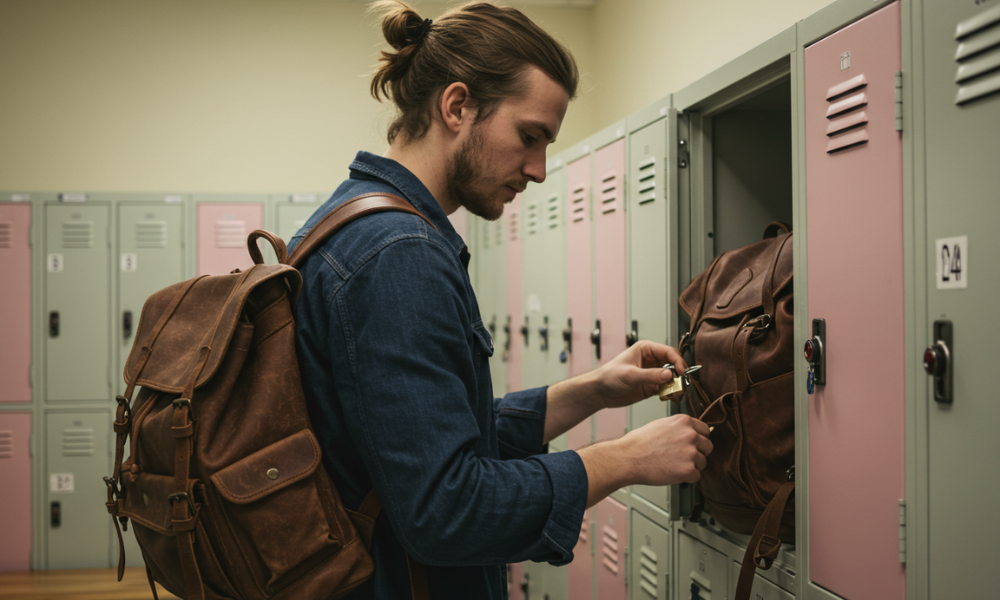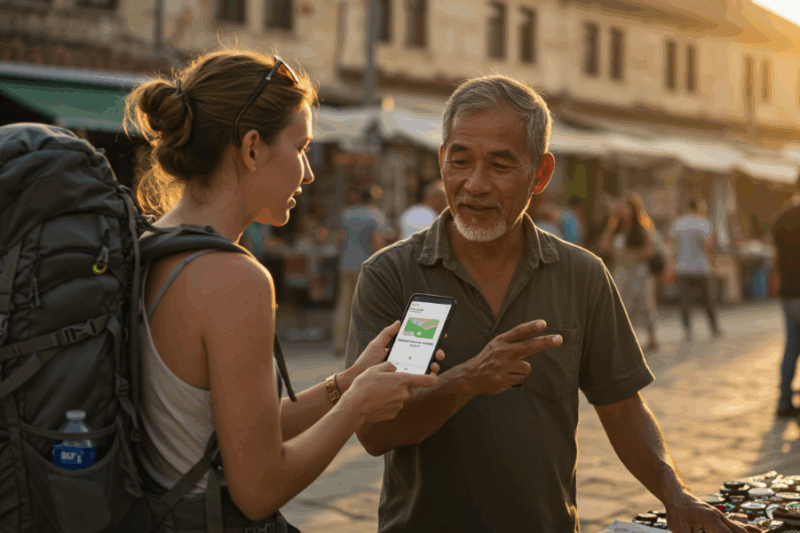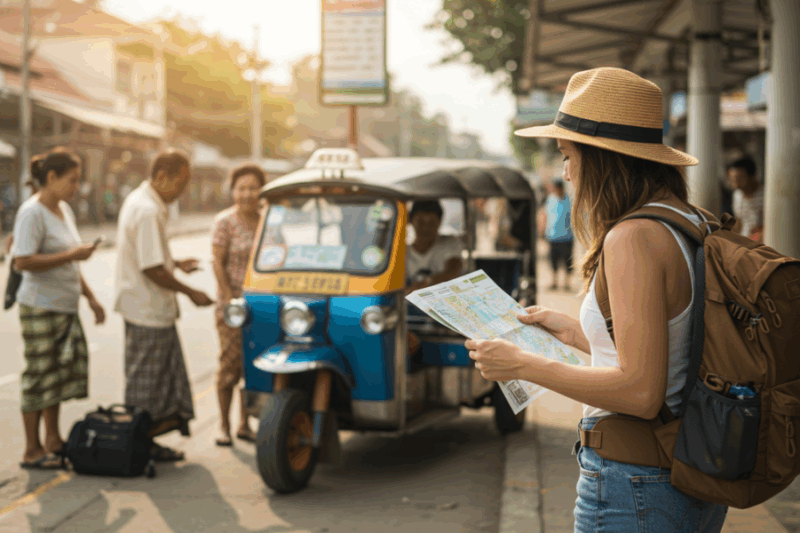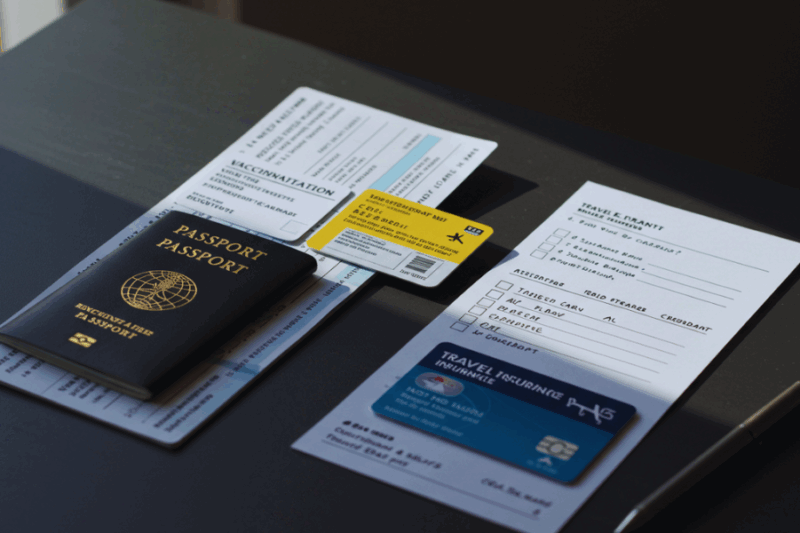Backpacking opens up a world of adventure, but for first-time travelers, staying safe is key to enjoying the journey. For minimalist backpackers, prioritizing safety aligns with traveling light, using simple tools and smart habits to navigate new destinations confidently. Whether you’re trekking through Southeast Asia or exploring South America, these practical tips ensure you stay secure with just a 20–30L carry-on and a budget-conscious mindset. Here’s a guide to essential safety strategies for novice backpackers, keeping your trip worry-free and uncluttered.

Why Safety Matters for First-Time Backpackers
In unfamiliar environments, small oversights—like flashing valuables or ignoring local scams—can lead to trouble. A safety-first approach lets you focus on experiences, from temple visits to market strolls, without stress. On my first backpacking trip in Thailand, these precautions saved me from pickpocketing in Bangkok’s markets and kept my daily costs at $20–30 by avoiding costly mishaps. These tips require minimal gear (phone, money belt) and empower you to travel confidently.
1. Research Your Destination Before You Go
Knowledge is your first line of defense. Research common scams, safe neighborhoods, and cultural norms using X posts, travel blogs, or Wikivoyage (free). In Hanoi, I learned to avoid fake taxi scams by checking X for “Vietnam travel safety.” Note emergency numbers (e.g., Thailand: 191, Vietnam: 113) and embassy contacts. Download offline apps like Maps.me (free) for navigation and Google Translate for local languages (e.g., Thai, Spanish). How to Do It: Spend 1–2 hours pre-trip searching “[destination] backpacker safety” on X or Google. Save key info in a notebook ($3) or phone notes. Download offline maps and emergency contacts.
Why It Works: Prepares you for risks, reducing surprises in unfamiliar places.
Time: Free, 1–2 hours.
2. Pack Light to Stay Mobile
A heavy backpack slows you down and makes you a target for theft. Use a 20–30L carry-on (e.g., Osprey Daylite, $50) to keep weight under 10 kg, meeting budget airline limits (e.g., AirAsia 7 kg) and avoiding $30–100 checked bag fees. In Cambodia, my 25L pack let me move swiftly through Phnom Penh’s crowded markets. Include a money belt ($10) for passport and cash, a padlock ($5) for hostel lockers, and a lightweight scarf ($5) for modesty or shade. How to Do It: Pack a capsule wardrobe (3 tops, 2 bottoms, $10–30 each), toiletries (<3.4 oz, $5–10), and essentials (phone, water bottle $15). Use packing cubes ($10–20) to organize. Test bag weight at home.
Why It Works: Light gear reduces theft risk and keeps you agile in busy areas.
Cost: $50–100 one-time for gear.
3. Keep Valuables Secure
Pickpocketing is common in tourist hubs like Bangkok’s Khao San Road or Lima’s plazas. Store your passport, cards, and $50–100 cash (local currency) in a money belt ($10) worn under clothing. In Laos, I kept my phone in a zipped pocket during market strolls. Use hostel lockers (padlock, $5) for backups. Carry a decoy wallet with $5–10 to hand over if confronted. Digital backups of IDs (Google Drive, free) ensure recovery if items are lost. How to Do It: Wear a money belt under clothes. Split cash ($20 in pocket, $50 hidden). Upload ID scans to cloud storage. Use lockers for non-essentials.
Why It Works: Minimizes loss impact, deterring thieves with low-value decoys.
Cost: $15–20 for money belt and padlock.
4. Use Safe and Affordable Transport
Unreliable transport can lead to scams or unsafe situations. Stick to licensed taxis, ride-hailing apps like Grab (Southeast Asia, $1–3/ride), or local buses ($0.30–2). In Vietnam, I used Grab bikes ($1) instead of unmarked taxis ($5–10), avoiding overcharges. Research transport options via Rome2Rio or Moovit (free). Avoid night travel in rural areas; book night buses ($5–15) from reputable firms (e.g., 12Go). Walk or rent bikes ($1–3/day) in safe, compact cities. How to Do It: Download Grab or local apps (e.g., Be in Vietnam). Book buses via 12Go. Confirm taxi fares or use meters. Carry small cash for fares.
Why It Works: Reduces scam risks and keeps transport at $2–5/day.
Cost Savings: $5–10/day vs. private taxis.
5. Stay Aware of Your Surroundings
Distraction makes you vulnerable to theft or scams. In Barcelona, I avoided pickpockets by keeping my bag in front at crowded La Rambla. Avoid flashing phones or cash in markets; use earphones sparingly to hear your environment. Trust your instincts—if a street feels off, take a detour. In Siem Reap, I walked confidently but stayed alert at night, sticking to lit areas. Learn basic phrases like “help” (e.g., “giúp tôi” in Vietnamese) to communicate emergencies. How to Do It: Keep bags in front in crowds. Avoid phone use while walking. Learn 2–3 emergency phrases via Google Translate. Walk purposefully.
Why It Works: Deters opportunists and keeps you in control.
Time: 5–10 minutes daily awareness.
6. Avoid Common Scams
Scams target first-timers, like fake tour guides or “free” bracelets leading to payment demands. In Thailand, I dodged a “closed temple” scam by checking Wat Pho’s hours online (open 8 AM–6 PM, $3 entry). Research scams on X (e.g., “[city] tourist scams”). Politely decline unsolicited offers—say “no, thank you” firmly. Use official ticket counters for attractions (e.g., Angkor Wat, $37) and avoid street touts. Carry a notebook ($3) to note legit vendors or prices. How to Do It: Search common scams pre-trip. Decline offers with a smile. Buy tickets from official sites or counters. Cross-check prices online.
Why It Works: Saves $5–20 per scam avoided, preserving your budget.
Cost Savings: $20–50/trip.
7. Stay Connected and Share Plans
Being reachable reduces risks if you’re lost or need help. Buy a local SIM (e.g., Viettel in Vietnam, $5 for 30GB/14 days) or use hostel Wi-Fi (free). In Malaysia, my Airalo eSIM ($10) kept me online for maps. Share your itinerary with a friend or family via WhatsApp (free), noting hostel addresses and travel dates. Check in daily, even briefly. Save emergency contacts (embassy, local police) in your phone. How to Do It: Buy a SIM at airports or use eSIMs (Airalo). Share plans via email or app. Save contacts offline. Check in daily (1-minute text).
Why It Works: Ensures help is accessible, easing emergencies.
Cost: $5–10 for SIM.
8. Trust Locals Wisely
Locals often offer genuine help, but exercise caution. In Hanoi, a hostel staff’s bus tip saved me $5, but I avoided a “friendly” stranger’s bar invite, a common scam. Ask hostel staff, vendors at busy stalls, or fellow travelers for advice—cross-check with X or apps. Be polite but firm when declining invitations. Learn greetings like “salaam” (Malaysia) to build trust without overcommitting. How to Do It: Seek advice from hostels or busy vendors. Verify tips online. Say “no, thank you” to unsolicited invites. Learn 2–3 local phrases.
Why It Works: Balances openness with caution, avoiding risky situations.
Time: 5 minutes/day for interactions.
Minimalist Safety Tips
- Pack Light: Carry a 20–30L backpack ($50) with money belt ($10), padlock ($5), scarf ($5), water bottle ($15), and first-aid kit ($5). Total <7 kg.
- Budget Wisely: Safety costs $15–30 one-time (gear, SIM); daily expenses $20–30 (hostel $5–10, food $5–8, transport $2–5). Save $5–10/day with local food/transport.
- Stay Prepared: Download offline apps (Maps.me, Google Translate, free). Carry $50–100 cash in local currency, split between belt and pocket.
- Cultural Respect: Dress modestly (scarf for temples, $5). Learn phrases like “thank you” (e.g., “cảm ơn” in Vietnam) to show respect.
- Health First: Carry hand sanitizer ($3), sunscreen ($5), and meds in a small kit ($5). Avoid tap water; use a reusable bottle ($15).
- Plan Smart: Research shoulder seasons (April–May, Sept–Oct) for fewer crowds. Book hostels 1–2 weeks via Hostelworld ($5–10/night).
Why These Safety Tips Work
These tips are tailored for first-time backpackers, using lightweight tools (money belt, phone) and habits to minimize risks. They saved me $50 on my Thailand trip by avoiding scams and fees, letting me focus on markets and temples at $20/day. Requiring minimal prep (1–2 hours) and gear (<7 kg), they align with minimalist travel—less worry, more freedom. From Chiang Mai’s streets to Cusco’s plazas, you’ll backpack with confidence.
Stay safe, pack light, and embrace your adventure. Where’s your first backpacking destination?




yrgozu
wmgcy2